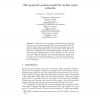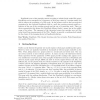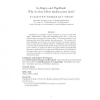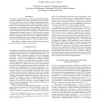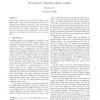IOR
2011
13 years 4 months ago
2011
This paper introduces and studies the maximum k-plex problem, which arises in social network analysis and has wider applicability in several important areas employing graph-based ...
CORR
2011
Springer
13 years 4 months ago
2011
Springer
ABSTRACT. Upon the discovery of power laws [8, 16, 30], a large body of work in complex network analysis has focused on developing generative models of graphs which mimick real-wor...
WAW
2010
Springer
13 years 7 months ago
2010
Springer
We introduce a new geometric, rank-based model for the link structure of on-line social networks (OSNs). In the geo-protean (GEO-P) model for OSNs nodes are identified with points ...
SIAMDM
2010
13 years 7 months ago
2010
Abstract. We investigate the degree distribution resulting from graph generation models based on rank-based attachment. In rank-based attachment, all vertices are ranked according ...
INFOCOM
2010
IEEE
13 years 7 months ago
2010
IEEE
— Retransmissions serve as the basic building block that communication protocols use to achieve reliable data transfer. Until recently, the number of retransmissions were thought...
IM
2007
13 years 9 months ago
2007
PageRank is one of the principle criteria according to which Google ranks Web pages. PageRank can be interpreted as a frequency of Web page visits by a random surfer and thus it r...
IM
2007
13 years 9 months ago
2007
PageRank is a popularity measure designed by Google to rank Web pages. Experiments confirm that PageRank values obey a power law with the same exponent as In-Degree values. This ...
CORR
2008
Springer
13 years 9 months ago
2008
Springer
A power law degree distribution is established for a graph evolution model based on the graph class of k-trees. This k-tree-based graph process can be viewed as an idealized model...
ICASSP
2010
IEEE
13 years 9 months ago
2010
IEEE
We present an approximation to the Bayesian hierarchical PitmanYor process language model which maintains the power law distribution over word tokens, while not requiring a comput...
SODA
2001
ACM
13 years 10 months ago
2001
ACM
Many massive graphs (such as the WWW graph and Call graphs) share certain universal characteristics which can be described by so-called the "power law". Here we determin...

